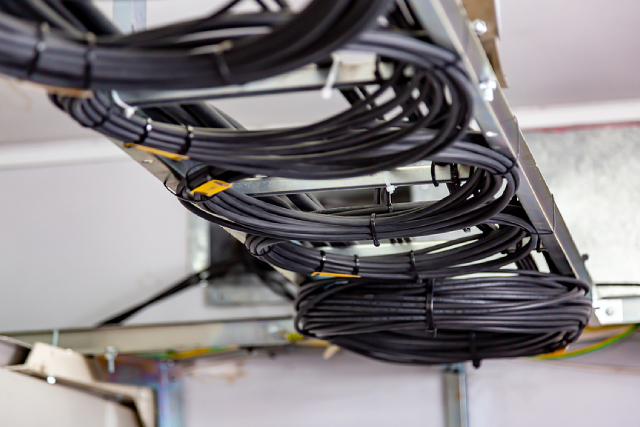Tackling Cable Management Woes with RFID Tech

In today’s fast‑paced business environment, maintaining high operational efficiency has become indispensable for organisations ranging from small and medium‑sized enterprises to large corporations. Central to this efficiency is the ability to track and manage cables accurately, which is more complex than it may seem at first glance. Underlying systems that power data and communication networks rely heavily on cables, and misidentifying a single cable during outages or maintenance can lead to significant downtime, financial loss, and reputational damage.
Traditional methods such as barcode labelling or manual inspection often fall short. Barcodes require direct line‑of‑sight; assets must be individually located, scanned, and logged, making the process time‑consuming, error‑prone, and costly. The more extensive the cable infrastructure, the greater the risk, especially in environments such as data centres, hospitals, manufacturing plants, and telecommunication facilities.
Recognising these limitations, industries are turning to a proven technology: radio‑frequency identification (RFID). By affixing RFID cable labels to physical cables or harnesses, organisations can achieve substantial gains in efficiency, accuracy, and cost reduction. Below is an in‑depth exploration of how RFID inventory tracking addresses the major challenges of cable management.
The Critical Need for Accurate Cable Identification
Cable infrastructures may appear insignificant when compared to larger assets, but their effective management can have profound operational consequences. In large installations, such as data centres, healthcare systems, manufacturing lines, or logistics hubs, cable volumes may reach tens of thousands. In such scenarios, locating the correct cable quickly becomes a logistical challenge.
Traditional tracing methods such as colour coding, handwritten labels, or barcodes often degrade or are obscured, increasing the risk of misidentification. Misplaced or misidentified cables can result in network disruptions, service delays, safety risks, and unnecessary expenditures—all avoidable with more accurate labelling and tracking approaches. Leveraging an RFID asset tracking system offers a clear path forward.
Overcoming the Limitations of Barcodes
Barcodes necessitate direct visibility and manual scanning. A technician must locate the barcode, ensure proper orientation, scan it, and then cross‑reference it in an inventory system. For installations with thousands of cables, this process is inefficient and prone to human error.
RFID differs from barcodes in that it operates without the need for sight. Handheld or fixed RFID readers can scan multiple tagged cables simultaneously, even within dense bundles or rugged containers. This allows for rapid bulk scanning, significantly reducing both time and effort during cable deployment, maintenance, or returns to storage.
Moreover, cables tagged with RFID can store more than just a serial identifier. Tags often contain memory capacity for storing maintenance logs, installation dates, length, type, and other relevant metadata. This ensures that key information can be retrieved during inspections and reduces reliance on external databases or paperwork.
Tackling Common Cable Management Challenges
Organisations face several recurring hurdles when managing extensive cable infrastructures:
1. High labour costs and inefficiency: Manual tracking inflates labour hours and slows down operations.
2. Human error: Manual entry is susceptible to mistakes, increasing the likelihood of costly outages.
3. Limited visibility: Real‑time status and location data are often unavailable through traditional methods.
4. Lifecycle issues: Failure to monitor usage leads to unexpected failures or premature replacements.
5. Replacement and repair costs: Lost or unidentified cables result in unnecessary reordering or idle inventory.
RFID technology directly addresses these issues.
The RFID Advantage
1. Accelerated operations and reduced labour
RFID enables rapid scanning of numerous cables simultaneously. In environments with thousands of cables, this batch processing capability can slash inspection times significantly compared to barcode systems. Automated data capture reduces manual registration, decreasing human error and lowering training requirements.
2. Enhanced Visibility and Less Downtime
RFID enables continuous visibility into cable location and status. In critical operations, such visibility prevents downtime caused by missing or misrouted cables. Emergency restoration becomes significantly faster and more reliable.
3. Lifecycle and predictive maintenance
RFID tags record usage frequency and maintenance history. This enables managers to predict when cables are likely to degrade, plan replacements in advance, and optimise inventory by identifying cables that are under‑ or over-utilised. Such lifecycle management reduces service interruptions and unnecessary stock levels.
4. Long‑term cost efficiency
Although deploying RFID requires upfront investment in tags and readers, organisations often recover these costs quickly. Labour savings, decreased downtime, avoidance of unnecessary replacements, and optimised inventory levels yield considerable return on investment. Industry data reveal repeated advantages of RFID over manual systems.
Industry Use Cases
Manufacturing and Logistics
In industrial settings, RFID cable ties embedded with tags offer robust, one‑step solutions for fastening, tagging, and tracking. These tags can endure harsh environments and retain accurate data storage. As components are tracked from assembly lines to distribution networks, cable tracing becomes more precise. Moreover, when cables exit racks or containers, automated read‑points instantly update usage logs.
Data Centers
Dense cable networks in data centres often require reconfiguration. RFID readers installed in cabinets and rack spaces provide instant visibility into cable positions and histories. A centralised system can then alert personnel to missing or misrouted cables, significantly reducing troubleshooting time.
Telecommunications and Infrastructure
Telecom environments with vast outdoor cable networks benefit from ruggedised RFID tags resistant to extreme conditions. These tags withstand UV exposure, temperature fluctuations, and physical impacts. Technicians can scan infrastructure miles apart without relying on visual checks, cutting operating costs and errors.
Conclusion
RFID technology delivers a transformative solution for identifying, tracking, and managing cable infrastructures. By deploying RFID‑enabled cable tags and integrating scanning hardware with backend software, organisations unlock real‑time insights into cable location, status, and usage. This leads to faster maintenance cycles, optimised inventories, improved asset lifecycles, and measurable cost savings. All in all, RFID presents a reliable and scalable framework for modern cable management, capable of meeting the stringent requirements of diverse industries.